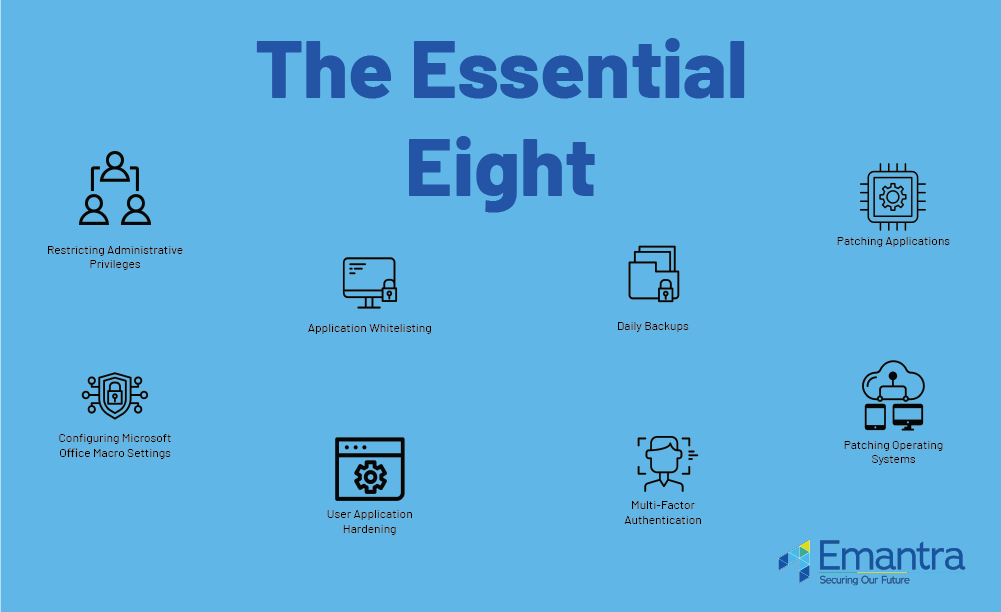According to the ASD in 2023, the average cost of a cybercrime for small businesses was $46,000, medium businesses $97,200 and large businesses $71,600. With the frequency and sophistication of cybercrimes escalating, it is vital to implement robust security measures to safeguard sensitive information and digital assets. The Australian Signals Directorate (ASD) has developed the Essential Eight, a set of cybersecurity strategies designed to combat common vulnerabilities and threats. By adopting these strategies, businesses can take a comprehensive approach to protecting their digital environments, significantly reducing the risk of cyberattacks.
Understanding Cybersecurity Essentials
The Essential Eight cybersecurity strategies are specifically developed to address common weaknesses that can expose systems to cyber threats. These strategies are designed not just as a reactive measure but as a proactive defence against potential attacks. By implementing the Essential Eight, organisations can strengthen their security posture and protect against a wide range of cyber threats. The core idea behind these strategies is simplicity—focus on key areas that yield the most significant security benefits.

If Your Business is New to the Essential Eight
For businesses that are new to the Essential Eight, prioritising the right strategies can make a significant difference. Here are the top three strategies recommended by Emantra’s cybersecurity experts that you can implement straight away:
-
Restricting Administrative Privileges: One of the most effective ways to prevent unauthorised changes and malware installation is by limiting access to administrative functions. Admin privileges should be granted only to those who absolutely need them, and even then, their usage should be closely monitored. By reducing the number of people with admin access, you minimise the risk of accidental or intentional security breaches. This strategy helps in maintaining a tighter control over your IT environment, making it harder for attackers to exploit elevated privileges.
-
Multi-Factor Authentication (MFA): Passwords alone are no longer sufficient to protect sensitive accounts. MFA requires users to provide multiple forms of verification—such as a password plus a fingerprint or a one-time code sent to a mobile device—before gaining access. This extra layer of security is crucial, especially for critical systems and accounts. Implementing MFA ensures that even if a password is compromised, the attacker cannot gain access without the additional required factors, thereby adding a robust layer of defence against unauthorised access.
-
Daily Backups: Regularly backing up your data is essential for preventing data loss and ensuring quick recovery in the event of a ransomware attack or system failure. Automated daily backups should be a standard practice, with backups stored securely in a location separate from your primary systems. This not only protects against data loss but also ensures that you can quickly restore your systems to their previous state with minimal downtime. It’s important to test your backups periodically to ensure they work correctly when needed.
Implementing the Essential Eight Strategies
To effectively implement the Essential Eight strategies, a structured approach is required. Start by conducting a thorough assessment of your current cybersecurity posture. This assessment should identify areas where your organisation is most vulnerable and where the Essential Eight strategies can have the greatest impact. Following this, develop a detailed implementation plan that prioritises the most critical areas first. For instance, if your organisation has a history of privilege-related breaches, restricting administrative privileges should be an immediate focus.
During the implementation process, it is crucial to overcome common challenges such as resource constraints and knowledge gaps. Leveraging external resources such as cybersecurity frameworks, MSSPs and consulting with experts can provide the necessary guidance and support. Engaging your IT team in regular training sessions can also ensure that everyone is aware of the importance of the Essential Eight and understands how to apply these strategies effectively.
Tips for Advanced Implementation
If your organisation has already implemented the Essential Eight strategies and is looking to further enhance its cybersecurity measures, consider the following advanced tips:
-
Seek Expert Advice: Cybersecurity is a complex field, and staying ahead of emerging threats requires continuous learning and adaptation. Consulting with cybersecurity experts can offer valuable insights into advanced implementation strategies. Partnering with a specialised cybersecurity firm, such as Emantra, can provide your organisation with tailored advice and support, ensuring that your security measures are not only up-to-date, implemented for you and future-proofed against evolving threats.
-
Continuous Monitoring and Improvement: Cybersecurity is not a set-and-forget task. It requires ongoing monitoring to detect and respond to new vulnerabilities and threats. Regularly reviewing and updating your security measures in line with the latest trends and technologies is essential. Continuous monitoring helps in identifying potential security gaps before they can be exploited. Additionally, staying informed about the latest developments in cybersecurity can provide you with the knowledge needed to adjust your strategies effectively. This proactive approach ensures that your defences remain resilient in the face of new and evolving cyber threats.
The Essential Eight strategies are crucial for any organisation looking to build a robust cybersecurity framework. By implementing these strategies, you can protect your digital assets and significantly reduce the risk of cyberattacks. However, it is important to remember that cybersecurity is an ongoing commitment, not a one-time effort. Regular updates, continuous monitoring, and a proactive approach to emerging threats are essential for maintaining a strong security posture. Start with the basics, but always be ready to evolve your strategies as the digital threat landscape changes. By doing so, you can safeguard your business and ensure that it remains resilient against the ever-present risks of the digital age.
If your organisation is ready to implement all Essential Eight strategies but doesn’t have the resources, check out Emantra’s CyberStart service.




